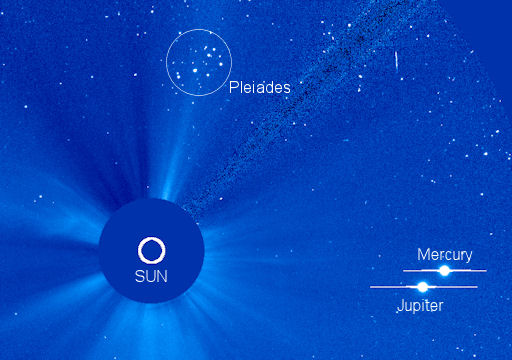QUIET SUN: With no sunspots actively flaring, the sun's x-ray output has flatlined. Solar activity is very low, and likely to remain so for the next 24 hours.
SUNSET CONJUNCTION: When the sun goes down tonight, step outside and look west. An exquisitely-slender crescent Moon is passing to the left of Venus. A small telescope pointed at Venus shows that it is a crescent, too. [sky map]
NOON CONJUNCTION: Mercury, Jupiter and the Pleiades are converging for a beautiful three-way conjunction. Unfortunately, it's happening in broad daylight. The two planets and the star cluster are only a few degrees from the sun. The Solar and Heliospheric Observatory (SOHO) photographed the encounter on May 22nd:
SOHO uses a coronagraph to block the glare of the sun, revealing what the human eye cannot see. Later today, Mercury and Jupiter will pass in the noon sky less than 1/3rd a degree apart. Join SOHO for a ringside seat.

Solar wind
speed: 419.9 km/sec
density: 1.2 protons/cm3
explanation | more data
Updated: Today at 1656 UT
![]()
X-ray Solar Flares
6-hr max: B4 1414 UT May22
24-hr: B5 0735 UT May22
explanation | more data
Updated: Today at: 1700 UT
![]()
![]()
![]()
Daily Sun: 22 May 12
![]()
![]()
None of the sunspots on the Earthside of the sun is actively flaring. Solar activity is low. Credit: SDO/HMI
![]()
![]()
![]()
Sunspot number: 120
What is the sunspot number?
Updated 21 May 2012
Spotless Days
Current Stretch: 0 days
2012 total: 0 days (0%)
2011 total: 2 days (<1%)
2010 total: 51 days (14%)
2009 total: 260 days (71%)
Since 2004: 821 days
Typical Solar Min: 486 days
Updated 21 May 2012
The Radio Sun
10.7 cm flux: 131 sfu
explanation | more data
Updated 21 May 2012
![]()
![]()
![]()
Current Auroral Oval:
![]()
Switch to: Europe, USA, New Zealand, Antarctica
Credit: NOAA/POES
![]()
![]()
![]()
Planetary K-index
Now: Kp= 3 quiet
24-hr max: Kp= 4 unsettled
explanation | more data
![]()
Interplanetary Mag. Field
Btotal: 12.4 nT
Bz: 2.1 nT north
explanation | more data
Updated: Today at 1656 UT
![]()
![]()
![]()
Coronal Holes: 22 May 12
![]()
![]()
There are no large coronal holes on the Earthside of the sun. Credit: SDO/AIA.





